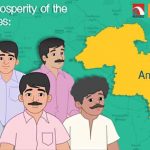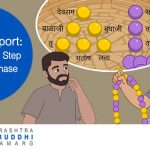
After willingly consenting to giving their land for the Samruddhi Project, the various landowners from 10 districts executed their land deals with the MSRDC. Once the landowners received the compensation amount from the direct purchase scheme in their respective bank accounts through RTGS, how and where is the money is now being utilized? This is the first part of a two-part series of some “Samruddha” stories – meaning “Tales of Prosperity” of some of the beneficiaries in Washim.
Vakil Garve of Imampur in Karanja taluka, Vishwanath Tathod of Dhanora Tathod village and Manikrao Thakare of Irala village in Malegaon taluka are among the many beneficiaries of the Samruddhi Project in Washim district. As much as each of their stories is inspiring, it also teaches us a valuable lesson or two.
Vakil Garve owned a total of 7.5 acres of land in Imampur village. The Garve family primarily cultivated Wheat, Gram, Cotton and Soybean. His family consists of just four members – him, his wife, his son and his father. He earned a good income from farming – ₹ 5 lac annually! Naturally, he opposed the Samruddhi Mahamarg scheme when the idea was first discussed in the village. About 4 acres of Vakil Garve’s land was going to be used for the purpose of the scheme. However, their opposition subsided when they realized that the MSRDC would be compensating them well for the land that would be utilized for the purpose of the scheme. He decided to buy a new farmland close by and start farming. He purchased a 5 acre, unused land in Baggi village. The land did not have a well; so he dug up a well on the land. Not just that, but with his own efforts Vakil ji managed to convert the piece of unused land into a green paradise in a very short amount of time.
He has planted Cabbage on one side of the field and Brinjal in another. Likewise, to ensure constant water supply for the crops, he has also installed a drip irrigation system. Vakil ji’s efforts have recently borne fruits – the crops are thriving in the field. The Garve family has made excellent provision for the balance money left after buying the farmland. They have purchased a plot in Karanja city and plan to build a house there one day. They have also kept aside some money for Vakil ji’s one and only son in the form of Fixed Deposit. Vakil ji tells us that this is a provision to meet his educational expenses.
Just like Vakil Garve, Vishwanath Tathod is another beneficiary from Washim. Vishwanath Tathod had two sons. The elder son, Bhuvaneshwar Tathod, manages the farm. The younger one is a Government Accountant. Tathod owns a total of 62 acres of farmland. A 100% dryland, the land is entirely dependent upon the dam. It’s good news if the rain fills up the water levels in the dam. Otherwise, the farmland remains dry. There was a well on the farm, but it did not have water for all 12 months. So, the well was also dependent upon the water from the dam. Because of this, the Tathod family had to cultivate crops on the 62 acre farmland, based on the rainfall. They would primarily cultivate Wheat, Gram, Soybean and Tur dal. Their farm has not given sufficient yield since the last two years due to lack of proper rainfall. They manage to cultivate Tur dal, since the crop does not require much water and grows in the available level of moisture in the land. The Tathod family had to satisfy themselves with whatever income they would earn from Tur dal cultivation. Even though the family owned a considerable large piece of land, they would not earn sufficient income due to the uncertain nature of the yield. The Tathod family gave up 3.75 acres of land for the Samruddhi Mahamarg project.
Tathod has promptly invested the compensation amount received in the form of a Fixed Deposit in a Co-operative Bank. He earns monthly interest from the FD, which takes care of the household expenses. The father doesn’t involve himself too much with the farming activities. Therefore, now his son, Bhuvaneshwar Tathod goes to the farm, monitors the work, the labour and looks after the crops. Twice earlier, Tathod’s land had been used up for some scheme due to the village being displaced. Therefore, he didn’t have a good opinion about any such schemes. But he is satisfied after giving up his land for the Samruddhi Mahamarg project as it has reduced the burden of the family’s day-to-day expenses.
Just like Vakil and Vishwanath, Manikrao Thakare of Irala villages expresses his satisfaction saying, “We’ve been blessed with prosperity!” He owned a total of 12 acres of land in the village, out of which 7 acres of land was purchased for the Samruddhi Mahamarg scheme. They would cultivate Cotton, Jowar, Soybean and Tur dal. The land being a dryland, the water situation was always dicey. To add to that, the texture of the land was of inferior quality as compared to that in the other villages, because of which the produce wasn’t satisfactory. His family consists of him, his wife, son, daughter-in-law and two grandchildren. He also has a daughter. The degradation in the quality of the output and the spoilt texture of the land was already giving the family a tough time. Therefore, Manikrao honestly mentions that they never felt like opposing the idea of giving up their land for the Samruddhi Mahamarg scheme. The family was already considering selling their land. The family was in need of money for some personal reasons, which is why Manikrao says that the compensation money received after giving up their land has been a massive relief. He also says that he will look for the right farmland as soon as possible, and consult the family in making a purchase decision only after studying the texture and quality of the land. He has also said that they will continue with traditional farming on the balance 5 acres of land remaining with them.
Likewise, thousands of beneficiaries from the rest of the districts are looking forward to a brighter future because the Samruddhi Mahamarg Project. Click on the link below to view the life changing stories of the beneficiaries from Washim district.


